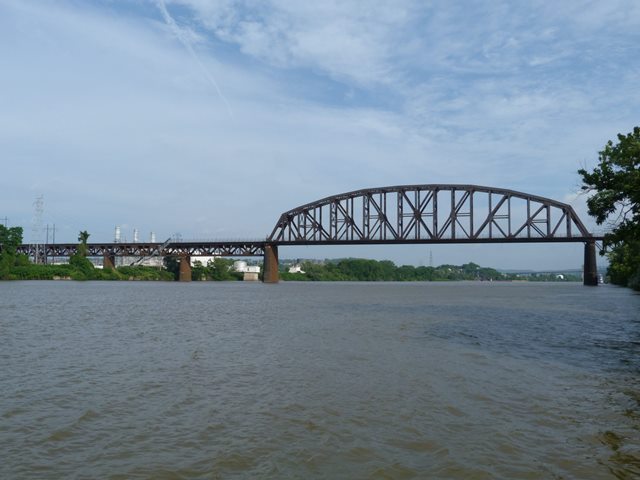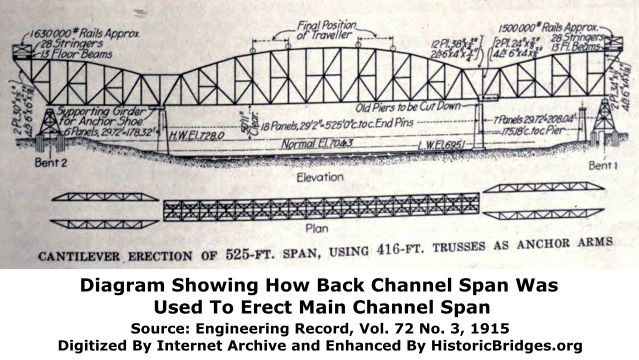We Recommend:
Bach Steel - Experts at historic truss bridge restoration.
BridgeHunter.com Phase 1 is released to the public! - Visit Now
Ohio Connecting Railroad Bridge
Brunot Island Railroad Bridge

Primary Photographer(s): Nathan Holth
Bridge Documented: August 2, 2007 and July 1, 2014
Pittsburgh: Allegheny County, Pennsylvania: United States
Metal 18 Panel Rivet-Connected Pennsylvania Through Truss, Fixed and Approach Spans: Metal 8 Panel Rivet-Connected Warren Deck Truss, Fixed
1915 By Builder/Contractor: American Bridge Company of New York, New York
Not Available or Not Applicable
525.0 Feet (160 Meters)
4,547.9 Feet (1386.2 Meters)
Not Available
2 Main Span(s)
Not Applicable

View Information About HSR Ratings
Bridge Documentation
View Historic American Engineering Record (HAER) Documentation For This Bridge
HAER Data Pages, PDF
View Historical Article About This Bridge
This impressive bridge is very long as uses Brunot Island to cross the Ohio River, and when completed its main channel span was the longest simple truss with riveted connections in the country. The bridge is one single bridge however and does not end on the island, instead crossing it via a series of riveted Warren deck truss spans. The spans over the river's main and back channels are massive riveted Pennsylvania truss spans.
The double-track bridge replaced an 1890 single track bridge. The new double-track bridge used the 1890 piers, which had been designed to support a two-track bridge, evidence of the railroad company thinking ahead to future expansion.
The erection of this bridge's 525 foot main channel is a truly fascinating story. As noted, there are two main through truss spans, separated by a series of deck truss spans. Engineers made use of the materials which would eventually compose the 416 foot back channel span to erect the main channel span. Half of the 416 foot span was erected, using false work at one end, on both ends of the location where the 525 foot span was to be erected. These spans acted as anchor arms, balancing the weight out, so that the 525 foot span could be erected using the cantilever method, which meant building the truss out from each pier, without using falsework to support the bridge. Additional construction materials, such as stringers and floorbeams were piled up on the top of the anchor trusses at the ends to provide for the proper anchor weight. This innovative method allowed for the construction to take place without obstructing the river traffic and having to deal with other inconveniences of falsework, while at the same time, not requiring additional construction materials on site by using parts that were would be needed anyway to compose the rest of the bridge.

Next to each of the main through truss spans is one deck truss span that is a pin-connected Pratt deck truss. These spans differ from the design of the bridge because they are from the original 1890 bridge. For unknown reasons, these spans were originally built as two-track spans, and so they were retained during the reconstruction.
![]()
Photo Galleries and Videos: Ohio Connecting Railroad Bridge
2014 Main Channel Spans Bridge Photo-Documentation
Original / Full Size PhotosA collection of overview and detail photos, most taken on the east side of the Ohio River, and therefore focusing on the Main Channel Spans. This gallery offers photos in the highest available resolution and file size in a touch-friendly popup viewer.
Alternatively, Browse Without Using Viewer
![]()
2014 Main Channel Spans Bridge Photo-Documentation
Mobile Optimized PhotosA collection of overview and detail photos, most taken on the east side of the Ohio River, and therefore focusing on the Main Channel Spans. This gallery features data-friendly, fast-loading photos in a touch-friendly popup viewer.
Alternatively, Browse Without Using Viewer
![]()
2007 Back Channel Spans Bridge Photo-Documentation
A collection of overview and detail photos, taken on the west side of the Ohio River, and therefore focusing on the Back Channel Spans. This photo gallery contains a combination of Original Size photos and Mobile Optimized photos in a touch-friendly popup viewer.Alternatively, Browse Without Using Viewer
![]()
Maps and Links: Ohio Connecting Railroad Bridge
Coordinates (Latitude, Longitude):
Search For Additional Bridge Listings:
Bridgehunter.com: View listed bridges within 0.5 miles (0.8 kilometers) of this bridge.
Bridgehunter.com: View listed bridges within 10 miles (16 kilometers) of this bridge.
Additional Maps:
Google Streetview (If Available)
GeoHack (Additional Links and Coordinates)
Apple Maps (Via DuckDuckGo Search)
Apple Maps (Apple devices only)
Android: Open Location In Your Map or GPS App
Flickr Gallery (Find Nearby Photos)
Wikimedia Commons (Find Nearby Photos)
Directions Via Sygic For Android
Directions Via Sygic For iOS and Android Dolphin Browser
USGS National Map (United States Only)
Historical USGS Topo Maps (United States Only)
Historic Aerials (United States Only)
CalTopo Maps (United States Only)





